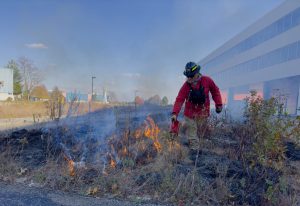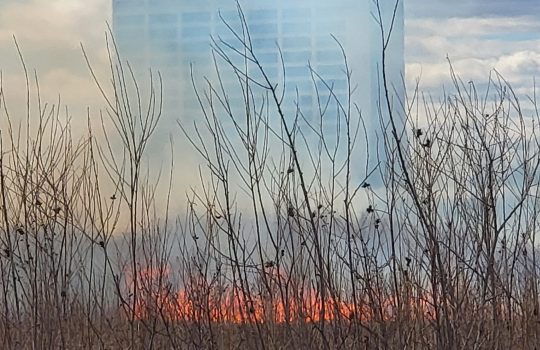Although firefighters in the Chicagoland region train extensively to fight fires in buildings, they don’t often train for fires erupting in natural areas, especially with live fires.
In early November, the U.S. Department of Energy’s Fermi National Accelerator Laboratory hosted the three-day training on combatting wildland fires. With more than 50 people attending this training, eight different municipalities and four conservation forestry groups from Cook, Will and DuPage counties were represented. Run by the Illinois Fire Service Institute, the Statutory Fire Academy for Illinois at the University of Illinois Urbana-Champaign trains more than 60,000 first responders across the state.

A firefighter conducts a prescribed burn on the Fermilab campus. Photo: Caitlyn Buongiorno, Fermilab
“We are thankful to Fermilab for opening their doors to our firefighters,” said Tom Richter, the wildland/prescribed fire program manager at IFSI. “Training is an essential part of being a firefighter, and allowing structural firefighters to train in wildland fire settings creates a safer Illinois.”
Wildlands are uncultivated sections of land set aside as a protected wilderness area, and fires in wildland settings can be caused by lightning or by people. Structural firefighters are trained to extinguish fires in buildings where they often have access to fire hydrants.
“In wildlands, we’re out in the open; there are no fire hydrants. So, in essence, the fire engines become the fire hydrants,” said Steve Hernandez, the fire chief for Fermilab’s Fire Department.
“Firefighters also fight wildland fires with fire by burning large areas to take away the fuel,” Hernandez said, “or we use tools to clear the lands and create a break between the area that is burning and the area that has not been affected.”
During the course, the firefighters learned about the basics of wildland fires and fire safety. The training covered the types of topography that can influence wildfires and how different plants can fuel the fires. They learned how weather and especially unpredictable winds can pose challenges for wildland firefighting. As live fires were used in Fermilab’s wildland areas for this training, preparation was essential and involved careful coordination with Fermilab’s ecology team.
Fire as a useful tool for ecological maintenance
Fermilab has more than 6,000 acres of land—10 square miles—with a large section that includes restored prairie, woodlands and other ecosystems. Intentional, controlled fires known as prescribed burns are one of the most effective land management tools to help Fermilab’s natural areas thrive. Fermilab’s ecology team regularly conducts prescribed burns on site in the spring and the fall, which made the lab an ideal place to conduct the IFSI training.
“Fire is a disturbance that keeps woody plants out, like brush and trees, so repeated fires help maintain a healthy prairie,” said Wally Levernier, Fermilab’s ecologist.
Left unchecked, trees and brush create shade that can prevent prairie dependent plants from growing, which destabilizes prairie ecosystems by creating a domino effect that can negatively impact pollinators.
“One of the other advantages of prescribed burning is specifically for our invasive species management,” said Levernier. “Imagine going through a prairie that hasn’t had a prescribed burn on it in the spring and looking for little sprouts of invasive species between the layers of thatch from previous years’ growth.”
Prescribed burns create a clean slate to spot invasive species when they emerge and help provide room for native species to establish themselves.
The wildland fire training provided much needed maintenance for Fermilab’s natural areas, while also deepening ties between Fermilab’s fire department and the fire departments that serve the surrounding communities.
“Fermilab’s fire department frequently trains with our community partners,” said Hernandez. “Because of that, we can effectively coordinate our efforts to keep people safe when we do need their personnel and resources.”
Fermi National Accelerator Laboratory is supported by the Office of Science of the U.S. Department of Energy. The Office of Science is the single largest supporter of basic research in the physical sciences in the United States and is working to address some of the most pressing challenges of our time. For more information, please visit science.energy.gov.

